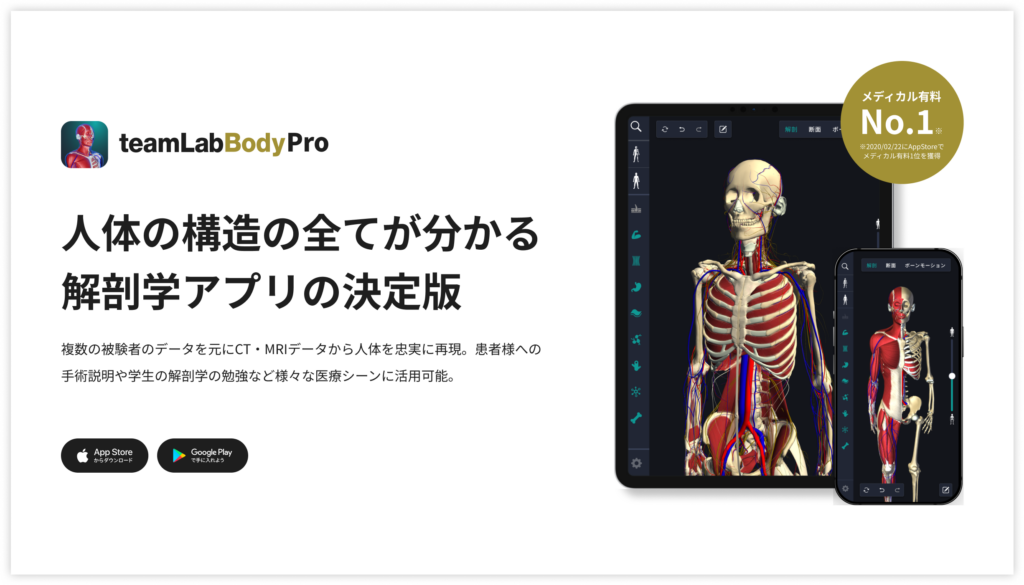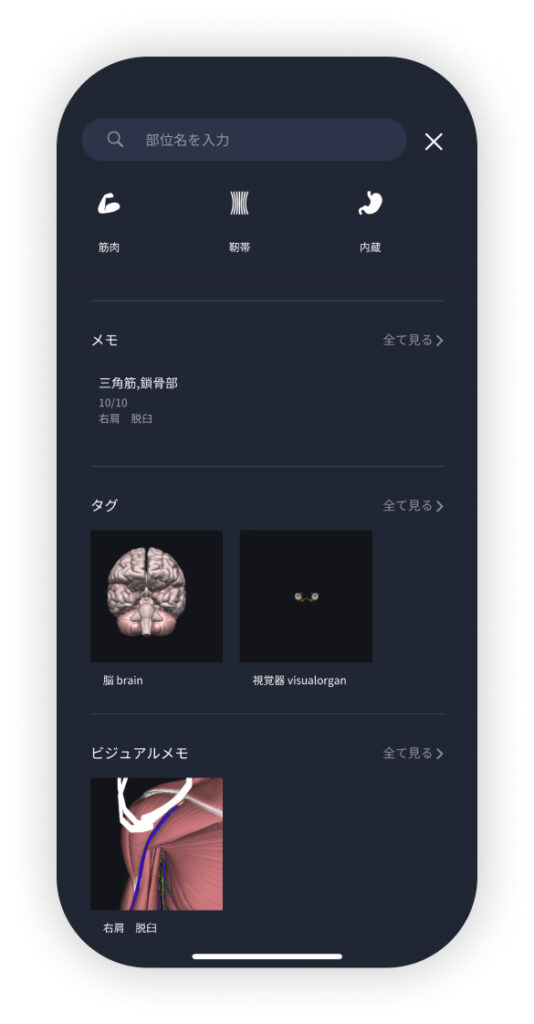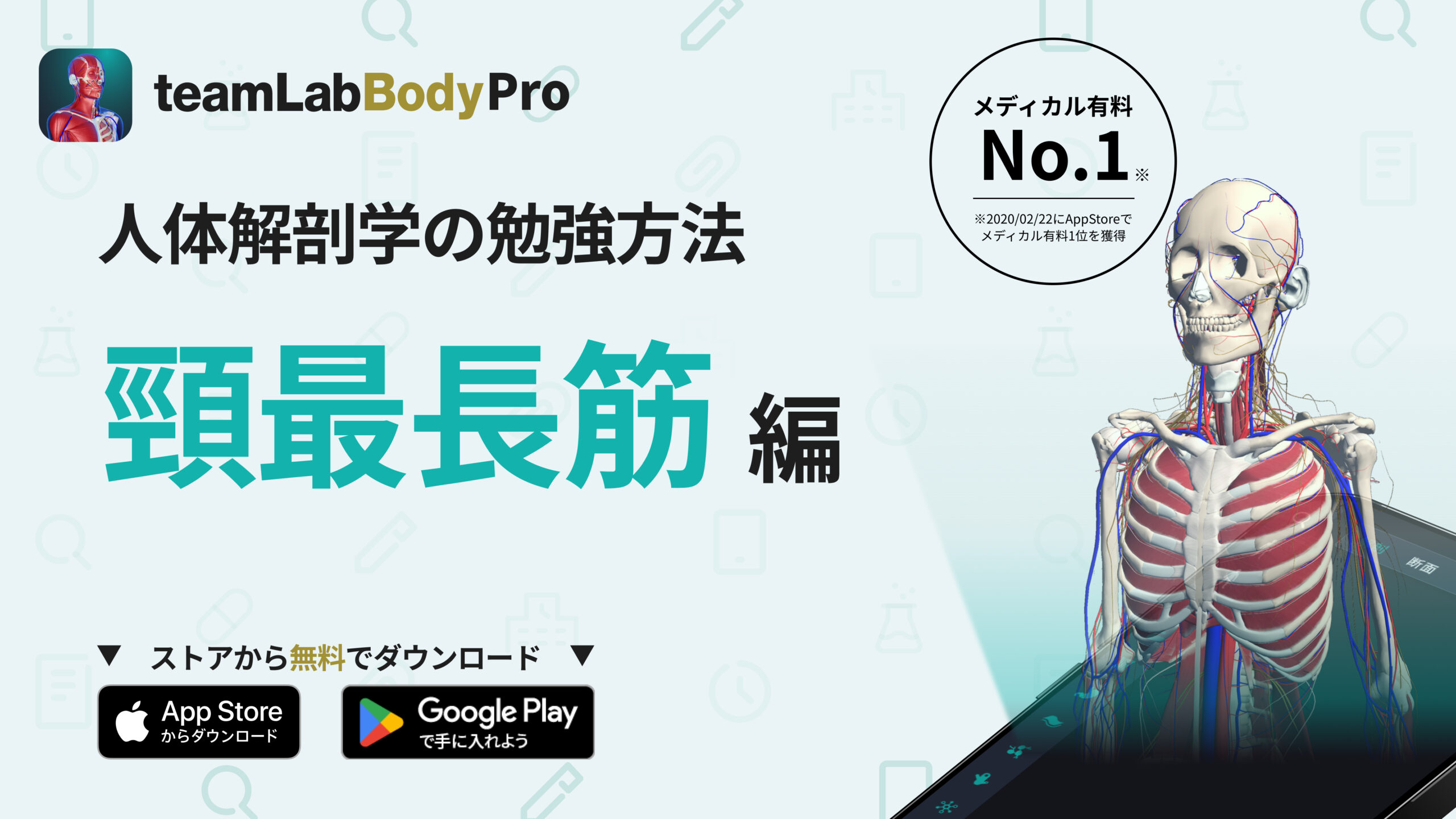beginning
In this article, I will explain effective study methods, starting with knowledge of specialized parts in human anatomy.
In human anatomy, it is necessary not only to memorize the names of various organs, muscles, and bones, but also to remember where they are located in the body. Therefore, it is necessary to learn as efficiently as possible.
I hope you will deepen your understanding even a little by reading this article and using the app.
Now, I'll explain the details about the “longest cervical muscle” and how to study human anatomy.
teamLab Body Pro Free Download
A 3D anatomy app that shows all the structures of the human body
Download teamLab Body Pro here!

What is the longissimus muscle of the neck?
In the anatomy application, you can view a selection of anatomy 3D models. In this model, there are various observation methods such as surfaces, cross-sections, and nervous systems. This time, I'll explain using an anatomy application.
About the longissimus longus muscle

The longissimus cervicis muscle (Longissimus cervicis) is part of the long dorsal muscle group and is an important muscle involved in back and neck movements. This muscle starts from the lateral protrusion of the thoracic spine (T1 to T5) and stops at the transverse projection of the cervical spine (C2 to C6). The longissimus cervix muscle is involved in movements that tilt the neck backwards (backward bending) and light rotational movements, and plays an important role in neck movement and posture maintenance in particular.
The longissimus cervical muscle cooperates with other back muscle groups and plays a role in stabilizing posture. In particular, it is a necessary muscle to expand the range of motion while maintaining stability in the spine and neck. When this muscle weakens, it limits the neck's range of motion and causes shoulder and neck pain.
The normal function of the longus cervical muscle allows smooth neck and back movements and improves posture, so neck and shoulder pain can be prevented. Also, strengthening muscles and maintaining flexibility are very important for maintaining health in everyday life.
Study points
Anatomical understanding
The longissimus cervicis muscle (Longissimus cervicis) is a muscle located deep in the back that is part of the longitudinal muscle group (Longissimus) and is mainly involved in neck and upper back movements. When learning this muscle, it is important to have a firm understanding of its anatomical position and structure.
Specifically, the longest cervical muscle starts from the lateral protrusion of the thoracic spine (T1 to T5) and stops at the transverse projection of the cervical spine (C2 to C6). As part of the long dorsal muscle group, the longus longus muscle is an important muscle involved in backflexion and rotation movements of the neck. Anatomically, it is important to understand the positional relationship of the longest neck muscle with other back muscle groups, such as the trapezius muscle, multifissure muscle, and spinal standing muscle. Visually learning how these muscle groups work together to influence posture and movement can help with learning.
Also, by using 3D anatomical diagrams and anatomy apps to visually capture muscle movements, you can understand their positional relationships and functions more deeply. The longissimus cervical muscle is a deep muscle and is difficult to see, so it is important to compare it with other muscle groups and deepen understanding of muscle movement and function.
Understanding muscle function
The longissimus cervix muscle plays an important role in backbending and rotational movements of the neck. Specifically, the longest neck muscle plays an active role when the neck is tilted backwards (backward bending), and its function is also important in rotational movements. In order to deepen functional understanding, it is effective to actually perform movements such as bending and rotating one's neck backwards, and to be aware of how the longissimus cervical muscle works at that time.
Furthermore, the longissimus cervical muscle cooperates with other back muscle groups, such as latissimus dorsi, multifissure, and trapezius muscles, and is involved in neck and back movements. It is important to understand how these muscles cooperate to support neck and back movements, and what role the longissimus cervical muscle plays in this, in order to learn how muscles work.
Strengthening neck and back muscles and increasing flexibility is also important for maintaining the function of the longitudinal neck muscle and preventing neck and shoulder pain. By learning how to exercise and stretch, you can effectively activate your longest neck muscle.
Practical applications
In order to strengthen the longissimus longus muscle, it is effective to mainly perform exercises and rotational movements to bend the neck backwards. For example, by doing exercises to bend your neck backwards while lying on your back, you can strengthen muscle strength targeting the longest neck muscle. Also, by incorporating light neck rotation exercises, it is possible to expand the range of motion of the muscles and improve neck flexibility.
Even in everyday life, in modern society where people often take the same posture for long periods of time, it is possible to prevent neck and shoulder pain by regularly bending the neck backwards or performing light rotational movements. These exercises are very effective for people who get stiff necks easily due to desk work, etc.
How to study human anatomy
I will explain specific study methods using human anatomy applications.
Check your past learning history and practice repeatedly
Here are the steps to check your anatomy learning history and practice iteratively effectively.
1. Check your learning history in the app
Reviewing your learning history with the application is an important step in effectively advancing anatomy learning. First, launch the app and go to the learning history section from the main menu. Many anatomy apps are designed to show your progress in the form of graphs and lists, so you can visually check which parts you've learned about and how much time you've spent.
By using this data, you can understand which areas you have strengths in and where you need to spend more time and effort. We also recommend using a dedicated tag or notebook function to mark areas you are particularly weak at or where you need to relearn. Regularly checking your learning history and looking back on past learning content will lead to efficient review and deepening understanding.
2.Make a plan for iterative learning
Making an efficient repetitive learning plan based on learning history is extremely effective in promoting knowledge retention. First, identify weak points and areas where you need to relearn. Next, arrange these study items into a weekly or monthly calendar and create a specific study schedule. By proceeding in a planned manner, you can learn each part evenly and avoid packing in a large amount of information at once.
Using a task management app or digital calendar to set study reminders is effective. Also, it's important to have the flexibility to regularly review progress and revise plans as needed. By having goals and proceeding with your studies in a planned manner, you can efficiently acquire anatomical knowledge.
3.Use 3D features to learn visually
By utilizing the 3D function, learning anatomy is easier to understand visually. The 3D model shows the structure of the human body three-dimensionally, and each part can be observed in detail. This makes it possible to intuitively grasp positional relationships between deep muscles and organs that are difficult to capture in a planar view. For example, you can learn even the smallest details by rotating specific muscles and bones and zooming in and out.
Also, there are many apps that have the function of displaying cross-sectional views of each part using a 3D model, which is useful for deepening understanding of internal structures. This diversity of visual information helps with memory retention and improves immediate responsiveness in tests and practice situations. By utilizing the 3D function and learning visually, you can learn anatomy knowledge more deeply and efficiently.
Use the memo function concretely

Make notes so you don't forget the things and points you've noticed while studying. The memo function can be used for different purposes, such as inputting text, saving images, and writing memos. Tag your notes to make them easier to review later.
Test your learning regularly in the form of quizzes
Regularly testing what you've learned in a quiz format is a very effective way to anchor your anatomy knowledge. Quiz-style tests help you objectively grasp your level of understanding and areas you lack while repeating knowledge.
For example, by using a learning app to conduct quizzes every specific period, you can reconfirm what you've learned and strengthen your memory. There are a wide range of quiz formats, such as multiple choice questions, fill-in-the-blank questions, and short answer questions, and each helps understanding from a different angle and develops the ability to utilize various types of knowledge.
Get feedback
If possible, get feedback from other learners and experts. It helps you find your own gaps in understanding and areas for improvement. You can also keep yourself motivated to learn by regularly testing yourself. Feeling a sense of accomplishment and progress increases motivation for continuous learning.
summary
This time, I explained how to study “longissimus cervical muscle” using an application!
Thank you for reading this far.
I would be happy if reading this article helped you learn about anatomy.
Learning is a long, never-ending journey, but I sincerely wish you all the best. Let's continue to study together and work hard for the national exam!
Please look forward to the next blog.
teamLab Body Pro Free Download
A 3D anatomy app that shows all the structures of the human body
Download teamLab Body Pro here!





